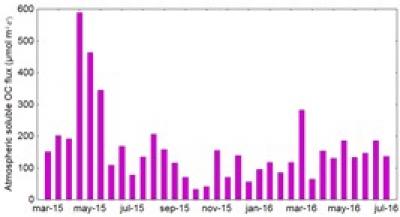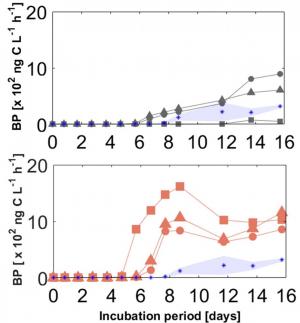Kahina Djaoudi (OT-Med PhD student)
Elvira Pulido, Christos Panagiotopoulos, Amel Nouara (MIO)
The Mediterranean Sea (MS) continuously receives anthropogenic aerosols as well as seasonal inputs from biomass burning and strong deposition pulses of Saharan dust. The deposition of these aerosols in the surface waters of the MS constitutes a major source of mineral nutrients. The fluxes and fate of the organic fraction of aerosols have been largely overlooked compared to the inorganic fraction. Consequently, current models of the carbon cycle in the MS do not account for atmospheric inputs of organic carbon (OC).
The fate of surface DOM, mineralized or exported, depends to a high extent on its biodegradability, particularly its C:N:P stoichiometry. Factors controlling the stoichiometry and degradability of the organic matter remain largely unknown.
The aim of this PhD thesis is to assess the contribution of atmospheric input to the C:N:P stoichiometry of surface DOM in the Mediterranean Sea. This assessment is carried out on two main mechanisms: a "direct" effect, through the input of new OM to the existing pool, and an "indirect" effect, through the stimulation of bacterial activity. Both an observation approach (atmospheric and marine monitoring) and an experimental approach (biogeochemical transformations of the DOM marine pool under the effect of an atmospheric input) are used, together with the ECO3M model in order to better understand the relationship between atmospheric input and the cycle of dissolved organic matter across the Mediterranean basin.
Atmospheric fluxes of soluble OC ranging from 30 to 600 µmol C m-2 d-1 were measured during 1.5 years at the Frioul Island (Figure 1). The annual flux of soluble OC to the MS was 59 mmol m-2, 6 times higher than inputs from the Rhone river. The OC content and fate of aerosol-derived OC was source-dependant:
- Anthropogenic aerosols showed a higher OC content and solubility than Saharan dust.
- However, OC derived from Saharan dust was more easily degraded by marine heterotrophic prokaryotes than OC derived from anthropogenic aerosols (Figure 2).
Fig 1: Atmospheric fluxes of soluble organic carbon (µmol m-2 d-1) measured at the Frioul Island between March 2015 and July 2016. Data from Djaoudi et al. (2018)
Fig 2: Bacterial production (x102 ng C L-1 h-1) during 16-days incubations performed in triplicate with marine heterotrophic bacteria growing on organic carbon from anthropogenic aerosols (upper panel, grey symbols) and Saharan dust (lower panel, orange symbols). The blue symbols correspond to the control treatment where no carbon source was added




